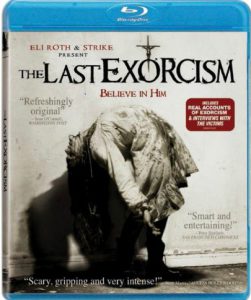The Devil always makes a great villain. That’s part of why M. Night Shyamalan’s new movie about people trapped on an elevator when weird things start to happen is so compelling: It’s called “Devil,” and that makes it all the more creepy because we wonder, “Is the Devil doing it?”
Although for me there is a large gap between finding the Devil fascinating and literally believing that supernatural beings are real, that doesn’t mean I just scoff when watching movies where an evil supernatural being is the bad guy. I find it fascinating and scary just like religious people, who might believe that the movie reflects reality.
“The Last Exorcism” puts a twist on the demon-possession genre in that this exorcist, Cotton Marcus (Patrick Fabian), is — if not a born-again atheist — at least someone with serious doubts about the literalness of the Bible. He performs exorcisms using smoke-and-mirrors tricks he learned from his magic hobby because he has read stories about real exorcists accidentally killing people. He wants “the possessed” to get their exorcism safely, and he feels he is helping them by giving them peace of mind. Also, he likes the cash.
So he accepts the job of exorcising Nell Sweetzer (Ashley Bell). And, of course, this is the point where it becomes a standard horror movie, but by no means a bad one.
The Sweetzer’s Louisiana farmhouse and surrounding lands are sufficiently overgrown and creepy, complete with the grave of Louis Sweetzer’s (Louis Hertham) wife right on the property.
Bell perfectly plays the innocent home-schooled girl who is overjoyed by the smallest compliment and says it’s the nicest thing anyone has ever done for her when documentarian Iris (Iris Bahr) gives her a pair of boots. The juxtaposition between a sweet girl and the incarnation of pure evil fighting within the same body always works in exorcism movies. It’s not all about Nell, though. The brother, Caleb (Caleb Landry Jones), is sufficiently shifty. And maybe there’s something about the dad, too.
Unfortunately, the movie also sticks with the conventions — and flaws — of the “hand-held documentary footage” genre. There are several moments in “The Last Exorcism” that reveal it was actually shot with multiple cameras. The two blatant giveaways are:
1, when two people are talking and the view instantly cuts between them, and
2, when the backing audio is an ongoing track even when the scene cuts to something else.
Granted, the one movie that faithfully stuck to the one-camera idea was “The Blair Witch Project,” and I thought it was boring and it made other people physically ill with all the camera-swinging and shaking. However, there are ways around that; for example, frame both of the people who are talking into the single shot. That’s what a lone cameraman would do anyway.
In this age of cheap thrills, not many will complain about “The Last Exorcism’s” lack of faithfulness to its premise. And I admit that it does everything else well; it builds suspense nicely and it held my attention throughout. It ends rather abruptly, but I’m not really a fan of overblown finales anyway, so I can’t complain too much.

“The Last Exorcism” is a fine addition to the demon-possession genre, even if it doesn’t reinvent it.

